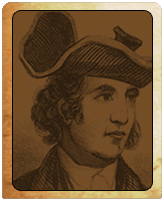
John Sullivan January 23, 1795, Durham, New Hampshire) was an American general in the Revolutionary War and a delegate in the Continental Congress.
Sullivan served as a major general in the Continental Army and as Governor (or "President") of New Hampshire. He is most famous for leading the Sullivan Expedition in 1779, a scorched earth campaign against the Iroquois towns that had taken up arms against the American
Early Career
Sullivan was the third son of a schoolmaster. He read law with Samuel Livermore of Portsmouth, New Hampshire, and began its practice in 1764 when he moved to Durham. He annoyed many neighbors in his early career, when he was the only lawyer in town, with numerous suits over foreclosures. But by 1772, he was firmly established and began work to improve his relations with the community. In 1773 Alexander Scammel joined John Sullivan's law practice.
He was sent by Durham to the colony's general assembly, and built a friendship with the royal governor John Wentworth. As the American Revolution grew nearer, he began to side more with the radicals. In 1774 the first Provincial (or rebel) Congress sent him as a delegate to the Continental Congress.
In 1775 he was returned to the Congress, but when they appointed him a brigadier general in June, he left to join the army at the siege of Boston.
Revolutionary War
After the British evacuated Boston in the spring of 1776, Washington sent General Sullivan north to replace the fallen John Thomas as commander in Canada. He took command of the sick and faltering invasion force, led an unsuccessful counterattack against the British at Trois-Rivières, and withdrew the survivors to Crown Point. This led to the first of several controversies between Congress and General Sullivan, as they sought a scapegoat for the failed invasion of Canada. He was exonerated and promoted to major general on August 9, 1776.
Sullivan rejoined Washington and was placed in command of the troops on Long Island to defend against British General Howe's forces about to envelop New York City. But then, on August 23, Washington split the command between Sullivan and General Israel Putnam. Confusion about the distribution of command contributed to the American defeat at the Battle of Long Island four days later. Sullivan's personal bravery was unquestioned, as he engaged the Hessian attackers with a pistol in each hand, however he was captured.
As a prisoner under parole, he carried letters from Admiral Richard Howe to the Congress. When the resulting peace discussions on Staten Island fell apart in September 1776 some in the Congress, particularly John Adams, found fault with Sullivan.
General Sullivan was released in a prisoner exchange in time to rejoin Washington before the Battle of Trenton. There his division secured the important bridge over the Assunpink Creek to the north of the town. This prevented escape and ensured the high number of Hessian prisoners captured. This route is now the main road in Ewing Township, New Jersey called "Sullivans Way". In January 1777, Sullivan also performed well in the Battle of Princeton.
In August, he led a failed attempt to retake Staten Island. Again Congress found fault, but he was exonerated by the court of inquiry. This was followed by American losses at Brandywine and Germantown. Congress was frustrated by the continued British occupation of Philadelphia, but since Washington was the only man holding the army together, they made Sullivan the scapegoat.
In early 1778 he was transferred to the unimportant post of Rhode Island where he commanded the largely unsuccessful Battle of Rhode Island in August 1778.
In the summer of 1779, Sullivan led the Sullivan Expedition, a massive campaign against the Iroquois in western New York. During this campaign, troops destroyed a very large Cayuga settlement, called Coreorgonel, on what is now the southwest side of Ithaca, New York.
He pushed his troops so hard that their horses became unusable, and killed them on this campaign, creating the namesake for Horseheads, New York. The lukewarm response of the Congress was more than he could accept. Broken, tired, and again opposed by Congress, he retired from the Army in 1779 and returned to New Hampshire.
After the war
At home Sullivan was a hero. New Hampshire returned him as a delegate to the Continental Congress in 1780. But he still had opponents there. In 1781 when he borrowed money from the French minister to Congress, they accused him of being a foreign agent. He resigned from the Congress in August 1781.
Back home again, he was named the state's attorney general in 1782 and served until 1786. During this same time he was elected to the state assembly, and served as speaker of the house. He led the drive in New Hampshire that led to ratification of the United States Constitution on June 21, 1788. He was elected President of New Hampshire (now Governor) in 1786, 1787, and in 1789.
When the new federal government was created, Washington named him federal judge for the District Court in New Hampshire in 1789. While his health prevented his sitting on the bench after 1792 he held the post until he died on January 23, 1795, aged 54, at his home in Durham. He was interred in the family cemetery there.
Legacies
Sullivan County, New York, Sullivan County, Pennsylvania, Sullivan County, New Hampshire, Sullivan County, Tennessee, and Sullivan County, Missouri were all named for him, as was Sullivan Street in Greenwich Village, Manhattan(?), and the General Sullivan Bridge spanning the Piscataqua River nearby to his home town of Durham, New Hampshire.
PREVIOUS: Nathanael Greene | John Sullivan | NEXT: Hugh Mercer
